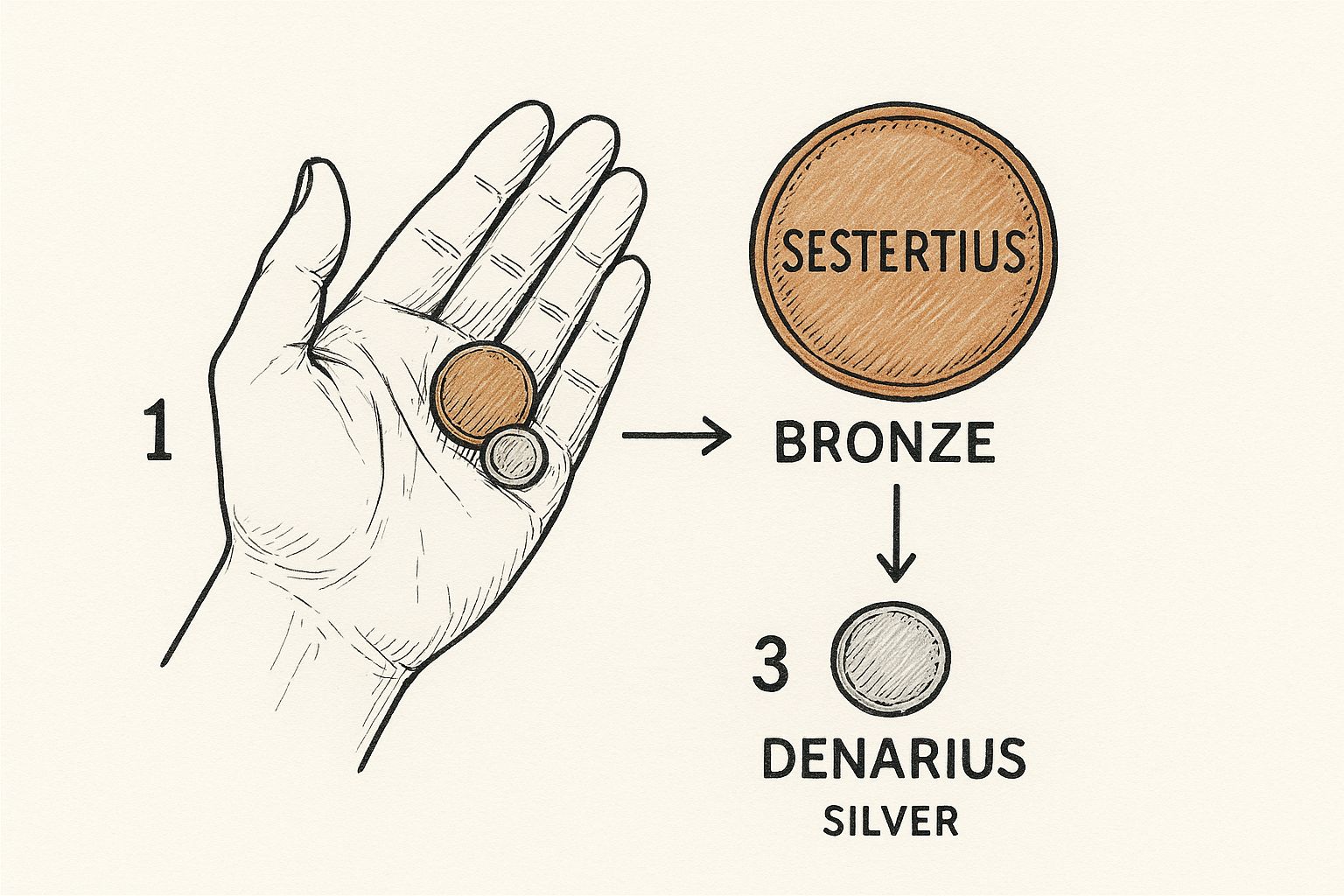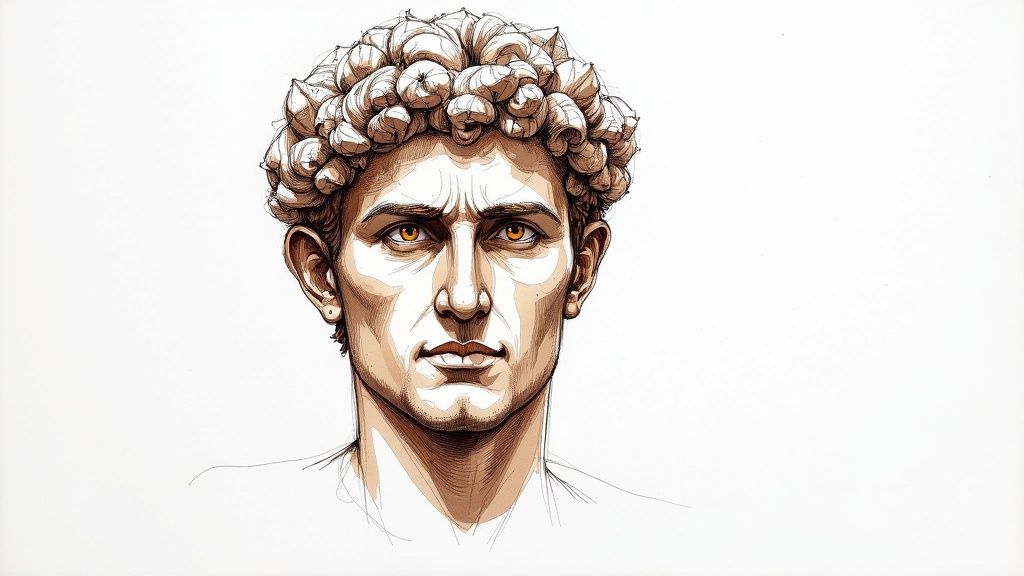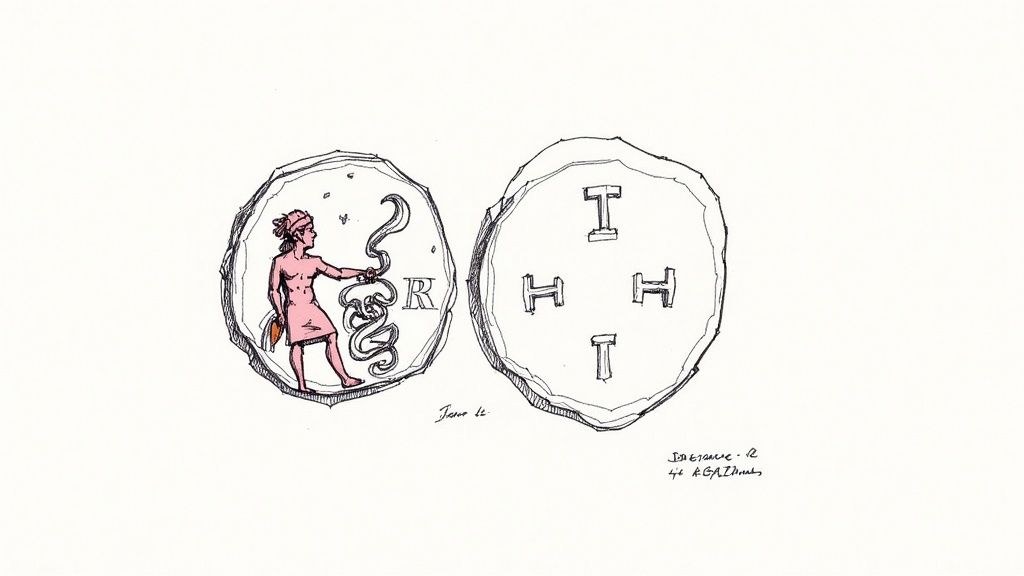Holding a piece of history that's 2,000 years old is an incredible feeling. But when you’re just starting out, that first attempt to identify a Roman coin can feel pretty daunting. Before you even think about decoding inscriptions or figuring out who that portrait is, just stop and look. The coin’s most basic physical traits—the metal, its size, and its general condition—are your foundational clues. Everything else builds from here.
Your First Look at a Roman Coin
When you first get your hands on a Roman coin, it's tempting to jump straight into searching for an emperor's name. Fight that urge. Instead, start with the most basic, tangible evidence you have. Think of yourself as a detective gathering the initial facts at a scene before you start building a case.
Your first observations should be simple: what's it made of and how big is it? Is it a small, shiny silver piece, or a big, heavy bronze one? Just answering that one question can instantly narrow down the possibilities. For instance, a small silver coin is very likely a Denarius, while a large bronze coin is often a Sestertius.
This initial assessment is absolutely vital. It gives you an immediate starting point for identification long before you try to decipher any text.

These denominations weren't random; they were the backbone of a complex monetary system that had a huge cultural and economic impact, especially in places like Britain after the Roman occupation kicked off in AD 43.
To help you get a feel for this, here's a quick reference table for some of the most common denominations you're likely to come across.
Common Roman Coin Denominations at a Glance
| Denomination | Common Metal | Approximate Diameter (mm) | Key Identifying Feature |
|---|---|---|---|
| Aureus | Gold | 19-21 | The only common gold coin; high value. |
| Denarius | Silver | 18-20 | The workhorse silver coin of the Empire. |
| Sestertius | Bronze/Brass | 25-35 | Large, heavy, and ideal for detailed portraits. |
| Dupondius | Bronze/Brass | 23-28 | Similar to an As, but emperor wears radiate crown. |
| As | Copper/Bronze | 23-28 | Common, reddish-copper appearance. |
| Antoninianus | Silver (debased) | 21-24 | Distinguished by the emperor's radiate crown. |
Remember, these are just general guidelines, as coin production wasn't as precise as it is today. Still, this table should give you a solid footing for your initial assessment.
It's crucial to treat every coin as a primary historical artefact. To get the most from your analysis, it helps to understand how to analyze primary sources. This mindset transforms a simple object into a rich piece of the past. For more foundational tips, our general guide on https://www.cavaliercoins.com/blogs/news/identify-ancient-coins is a great place to continue.
Decoding the Imperial Portraits

The portrait on a Roman coin’s obverse (the ‘heads’ side) is your single most powerful tool to identify a Roman coin. This isn't just some generic face; it's a carefully crafted piece of propaganda showing a specific emperor, empress, or another imperial figure. Honing your ability to read these portraits is a cornerstone skill in numismatics.
Each ruler’s image projected a particular message—power, piety, military might, or youthful vigour. These styles shifted dramatically over the centuries, leaving us with brilliant visual clues for different eras. Early emperors like Augustus, for instance, were often shown with a clean-shaven, almost classical Greek look, meant to symbolise a return to tradition.
Analysing Distinctive Features
When you're looking at a portrait, you need to train your eye to look past the general face and zero in on the small details. These are the fingerprints that point to a specific ruler, and they’re often far more reliable than worn-down inscriptions, especially on lower-grade coins.
I always tell new collectors to look for these key visual clues:
- Hairstyles: Pay close attention to the hair. Is it the tight, neat curls you see on Nero, or the longer, flowing locks of Constantine the Great? This detail alone can narrow down your search in an instant.
- Facial Hair: The presence of a beard—or lack thereof—is a massive giveaway. Beards really came into fashion with Emperor Hadrian and became a common sight on the soldier-emperors of the 3rd century.
- Headwear: What’s on the emperor's head? Is it a laurel wreath (a classic sign of victory), a spiky radiate crown (which often indicates a double-value coin like an Antoninianus), or a diadem (which became common in the late Empire)?
- Facial Structure: Look for unique features. Does the portrait have Vespasian's famously strong jaw and receding hairline, or the stern, almost blocky features of Diocletian?
A perfect real-world example is telling Trajan and Hadrian apart. Trajan is always shown clean-shaven. His successor, Hadrian, was the very first emperor to make beards popular, marking a huge stylistic change. That one simple detail is often enough to instantly distinguish their coins.
By learning to spot these features, you transform a simple metal disc into a personal link to a specific Roman ruler. This visual detective work turns the challenge to identify a Roman coin into a fascinating historical puzzle, letting you piece together its identity even when other parts are worn away.
Reading the Story in the Inscriptions
Beyond the emperor's portrait, the coin really starts to tell its story through the abbreviated Latin text, known as the legend. To a beginner, it can look like an indecipherable jumble of letters, but this is where you'll find the most crucial details for identifying your coin. Think of it as the coin’s official headline, announcing who the emperor is and what powers they hold.
Your first task is to find the emperor's name. It’s often split up and arranged around the portrait, so you’ll usually need to read it clockwise. Look for common titles that act as helpful signposts, like ‘AVG’ for Augustus (Emperor) or ‘CAES’ for Caesar (often a junior emperor or heir). These abbreviations are your keys to unlocking the rest of the text.
Once you’ve pieced together a potential name, you can start digging into the deeper story.
Decoding Imperial Titles and Powers
Many legends feature a whole string of additional titles, which provide a fantastic amount of political and historical context. These abbreviations detail the specific offices an emperor held when the coin was minted, making them incredibly useful for dating.
Here are some of the most common ones you'll come across:
- PM or PONT MAX: Pontifex Maximus, the chief high priest.
- TRP or TRIB POT: Tribunicia Potestas, their power as Tribune of the people.
- COS: Consul, usually followed by a Roman numeral (e.g., COS II means he held the office for the second time).
- PP: Pater Patriae, meaning 'Father of the Country'.
The Roman mints churned out an incredible number of coins; some estimates suggest that around 20 billion coins were struck over the empire's lifetime. This massive output was essential for broadcasting the emperor's messages across a vast territory. You can get a sense of these production numbers over at Forum Ancient Coins. This made every single coin a tiny, yet powerful, piece of propaganda.
The reverse side often switches from official titles to celebratory slogans. A phrase like 'VICTORIA AVGVSTI' shouts about a military victory for the emperor, while 'FIDES MILITVM' was meant to assure everyone of the army's loyalty.
Take a look at this screenshot from WildWinds, an indispensable online database for identification. It shows exactly how these inscriptions are catalogued.
Each entry carefully transcribes the obverse and reverse legends, letting you match the letters on your coin to professionally identified examples. By piecing together the name, the titles, and the declarations, you're essentially reading an official bulletin from a specific moment in Roman history.
Uncovering Clues on the Reverse

If the emperor's portrait on the obverse tells you who was in power, flipping the coin over reveals the story of what was on their mind. The reverse was prime real estate for imperial propaganda, broadcasting messages of military might, public wellbeing, and divine approval to every corner of the Roman world.
This imagery is often symbolic, celebrating real-world events or representing abstract concepts. Learning to read this visual language is a vital step to identify a Roman coin and truly get to grips with its history. Every figure, every object, was chosen for a reason.
You might find personifications of virtues the emperor wanted to be known for, for example. These weren't just pretty pictures; they were carefully calculated political statements stamped in metal.
Common Reverse Themes to Look For
The sheer variety of reverse designs can feel overwhelming at first, but thankfully, many fall into a few key categories. Get familiar with these, and you'll find your identification process speeds up immensely.
- Gods and Goddesses: Deities were a constant feature. Jupiter with his thunderbolt or a spear-wielding Mars were popular ways to connect the emperor with divine power and military prowess.
- Virtues Personified: You'll frequently see figures representing concepts like SALVS (health), often shown feeding a serpent, or FORTVNA (good fortune) clutching a rudder and cornucopia.
- Military Victories: A depiction of Victoria, the goddess of victory, holding a wreath or palm branch was a classic way to commemorate a successful military campaign.
- Architectural Marvels: While less common, some coins celebrated major building projects. Famous examples show off constructions like the Colosseum or Trajan's Column.
The reverse doesn't just give you a theme; it often holds the key to the coin's origin: the mint mark. These tiny letters, usually tucked away at the bottom in an area called the exergue, tell you exactly where your coin was struck.
Spotting a mint mark like ‘R’ for Rome or ‘LVG’ for Lugdunum (modern-day Lyon) is a huge breakthrough. It adds another fascinating layer to your coin’s story, linking it to a specific city and workshop within the vast Roman Empire. More often than not, this little detail is the final piece of the puzzle.
Essential Tools for Coin Identification
Once you've squeezed every last clue from your coin's portrait, inscriptions, and reverse design, it's time to bring in the big guns. No expert, no matter how seasoned, can identify every Roman coin from memory alone. We all rely on a powerful toolkit of online databases and classic printed catalogues. Learning your way around these resources is the final, crucial step in confidently putting a name to your coin.
In recent years, the digital resources available to collectors have become truly incredible. Websites like WildWinds and Online Coins of the Roman Empire (OCRE) are absolutely indispensable. These databases let you plug in the details you’ve found—like the emperor’s name or a snippet of the reverse legend—and instantly pull up matching examples with their official catalogue numbers.
Navigating Digital Databases
The real power of these online tools lies in their visual nature. Instead of trying to decipher a dense text description, you can compare your coin side-by-side with high-quality photos of professionally identified examples. This is where all your careful observation really pays off.
You can see below how OCRE allows you to filter your search by ruler, metal, and even the specific text on the coin. It’s a brilliant way to quickly narrow down the possibilities from thousands to just a handful.
What's more, the platform often links directly to the world's biggest museum collections, giving you access to countless authenticated coins to cross-reference against your own.
But for all their convenience, digital tools haven't completely replaced the traditional printed catalogues. These books are still the definitive authorities in the field. The multi-volume Roman Imperial Coinage (RIC) series is the undisputed gold standard—it's the ultimate reference bible for any serious collector and is the system used by dealers and auction houses everywhere.
Of course, to use any of these tools effectively, you need a clear view of your own coin. Good magnification is a start, but high-quality photographs are essential for detailed study and for getting a second opinion from others. If you need some pointers, this guide on how to take professional product photos at home is a great resource.
The sheer variety of Roman coins can be staggering. A modern analysis of coins found in England and Wales catalogued nearly half a million finds, revealing fascinating patterns in their circulation. It really highlights just how many different types are out there.
Before you can start comparing or photographing, however, the coin has to be clean enough to see. If your find is covered in centuries of grime, our guide on how to clean dirty and rusty coins will walk you through the process safely.
Common Questions About Roman Coins
As you dive deeper into the world of Roman numismatics, you'll naturally start running into some common questions. Working through these is a rite of passage for every collector learning to confidently identify a Roman coin. Let's tackle a few of the most frequent queries that come up.
How Can I Tell If My Roman Coin Is a Fake?
Developing an eye for authenticity is a skill built over time, but there are some immediate red flags to look for. One of the biggest giveaways is a casting seam along the coin's edge. Genuine Roman coins were struck, not cast, a process that gives them sharp, crisp details and a solid, satisfying feel in hand.
Look out for details that seem soft or have a ‘soapy’ appearance, or a weight that just feels off for its size and metal type. The artistic style is another massive clue. Does the emperor's portrait look right for the period? If you have any serious doubts, especially with a potentially valuable coin, the best thing you can do is consult a reputable dealer or a professional grading service.
What Is the Best Way to Clean a Dirty Roman Coin?
The golden rule here is to proceed with extreme caution—less is almost always more. Aggressive cleaning can permanently destroy a coin's historical character and obliterate its value.
For those crusty bronze coins that look like they just came out of the ground, a long soak in distilled water can work wonders. It gently loosens the dirt without stripping away the patina, which is the aged surface collectors prize. Whatever you do, never use harsh chemicals, acids, or a wire brush. For silver and gold coins, the best method is usually no cleaning at all. An untouched coin is far more desirable than a badly cleaned and damaged one.
The condition of a coin absolutely affects its identification. A well-preserved coin with clear legends is much easier to attribute than a heavily worn one where you might only be able to make a broad guess, like 'a bronze coin of the 3rd century'.
To get a better handle on how preservation affects a coin's story and value, take a look at our detailed coin grading guide for beginners and experts.
At Cavalier Coins Ltd, we provide a vast selection of authenticated coins for every level of collector. Explore our curated collections at https://www.cavaliercoins.com.

